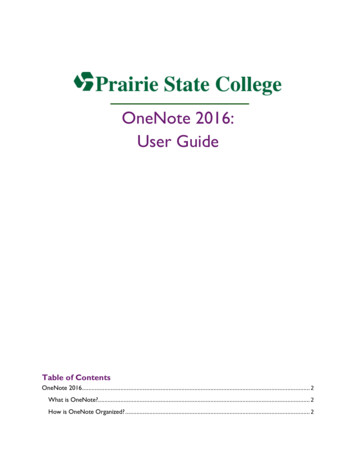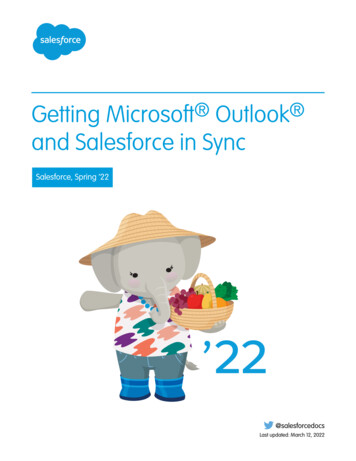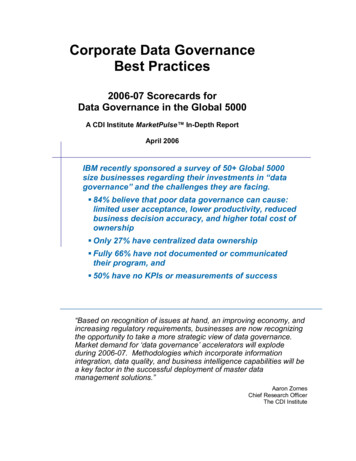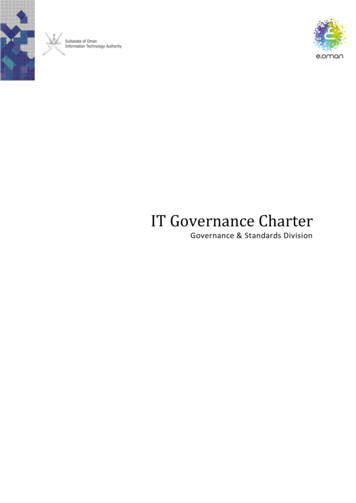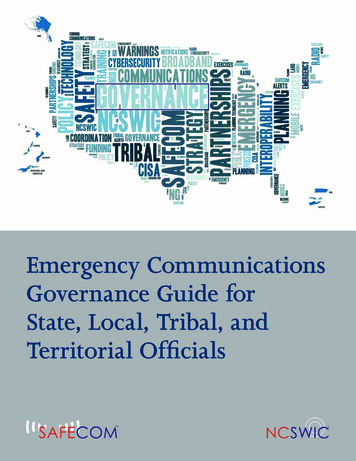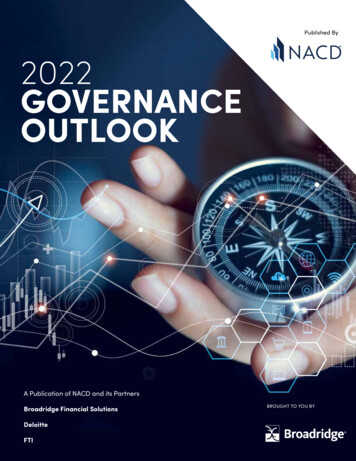
Transcription
Published By2022GOVERNANCEOUTLOOKA Publication of NACD and its PartnersBroadridge Financial SolutionsDeloitteFTIBROUGHT TO YOU BY
Support for the 2022 Governance Outlook was provided by the following partners, who wereinstrumental in the formulation of this publication:Broadridge Financial SolutionsDeloitteFTIAbout This ReportThe 2022 Governance Outlook is designed to give corporate directors and senior executivesa comprehensive overview of major business and governance issues that are likely to demandboard focus over the coming year. The report begins with an introduction from NACD thathighlights survey findings about leading board priorities for 2022 and follows with four partnercontributions that provide distinct insights and projections on the following themes: proxypriorities, ESG oversight, M&A oversight and purpose, ransomware risk, assessing DE&I practices,and D&O threat landscape.Each partner contribution provides (1) an overview of key trends in a particular area of governance,(2) an outlook for how those trends will play out in 2022, and (3) relevant implications andquestions for boards to consider. The 2022 Governance Outlook is designed as a collectionof observations to help corporate boards to prioritize their focus in 2022 and increase theirawareness of emerging issues through both detailed topical analysis and coverage of broadergovernance implications.National Association of Corporate Directors Copyright 2021, National Association of Corporate Directors. All rights reserved.Except as permitted under the US Copyright Act of 1976, no part of this publication may be reproduced,modified, or distributed in any form or by any means, including, but not limited to, scanning and digitization,without prior written permission from NACD.This publication is designed to provide authoritative commentary in regard to the subject matter covered.It is provided with the understanding that neither the authors nor the publisher, the National Associationof Corporate Directors, is engaged in rendering legal, accounting, or other professional services throughthis publication. If legal advice or expert assistance is required, the services of a qualified and competentprofessional should be sought.
ContentsBoard Agendas Must Change to Meet 2022 Director Priorities.2By Barton Edgerton, NACDEmbracing Greater Investor Interest in ESG Practices.7By Dorothy J. Flynn and Chuck Callan, BroadridgeThe Role of the Board in Overseeing ESG.12By Kristen Sullivan, Maureen Bujno and Jon Raphael, DeloitteHow Purpose Is Changing the Board M&A Oversight Role: What DirectorsAre Saying.19By Nikki Beck and Annie Adams, DeloitteBoard Responsibilities in Mitigating Ransomware Risk in 2022.26By Donald Saelinger, FlashpointThe Role of Boards in Assessing DE&I Practices with Advanced DataAnalytics.34By Alok Khare, FTIDirectors and Officers Liability Threat and Insurance 2022 Outlook.39By Priya Cherian Huskins, Woodruff SawyerContributing Partners.4312022 Governance Outlook
Board Agendas Must Change to Meet 2022 DirectorPrioritiesBarton Edgerton, NACDINTRODUCTIONAlthough many had hoped that 2022 would see a return to normal, COVID-19 variants,supply chain disruptions, and inflationary pressures suggest that next year will continueto challenge corporate boards as they and their management teams continue tonavigate a demanding business environment. Furthermore, larger social concernsabout ESG and DE&I will make it difficult for many boards to return to the status quowhen—or if—the pandemic recedes.To gain better insight into which trends directors believe are most likely to impacttheir organizations in 2022, where directors allocate too much or too little time, andwhat priorities they have for making improvements, NACD surveyed nearly 250 membersin November 2021 as part of its annual Director Trends and Priorities report.Overall, directors report some significant changes in what will affect their firms.A greater emphasis on talent and digital transformation suggests that many forcesare changing how work gets done in American companies. This should come as nosurprise to the vast majority of board members who have embraced the potential ofvirtual meeting tools to transform the board’s work.Competition for Talent is Overwhelming the Top Reported TrendSince last year, increased competition for talent has bolted to the top of the list oftrends that directors believe are most likely to impact their organizations over thenext 12 months. Further, it was a top-five choice of 70 percent of survey respondents,an unprecedented finding since over the last several years the top trends havestruggled to receive majority consensus. Further behind, directors saw the increasing22022 Governance Outlook
pace of digital transformation (42%) as the second-placed trend. More than two inthree directors noted that their boards had discussed risk factors associated with the“Great Resignation.” Taken together, this suggests that a variety of factors affectingthe way that work (more remote, more virtual, and with more digital tools) gets donenow are likely to impact not only how organizations operate but also the discussionsthat boards have. Other, more economic challenges, such as the slowing global supplychain (41%) and growing inflation follow (35%). Cybersecurity (39%) remains a perpetualconcern and rounds out the top five.Room in the top five was created by several significant drops in the rankings ofseveral trends. The pace of business model disruptions dropped from third in 2021to eighth this year. Change in customer behaviors dropped from 8 to 12. But thelargest fall was in ensuring a safe working environment, which dropped from 2 to 14.While health and safety remain a top concern, most of the impact it has on the firmis already well managed, with 88% of directors reporting that they are confident theirmanagement teams can handle it.What five trends do you foresee having the greatest effect on yourcompany over the next 12 months?Increased competition for talentIncreasing pace of digital transformationSlowing global supply chainChanging cybersecurity threatsGrowing inflation42.0%40.8%38.7%34.9%Increased regulatory burden31.9%Uncertain pace of the economic recovery27.3%Growing business-model disruptions26.1%Shifting workplace demographics22.7%Increased pace of M&A activity22.3%Growing impact of climate change19.7%Changes in consumer spending and behaviors18.5%Increasing political uncertainty in the United States17.2%Ensuring a safe working environment for employees17.2%Increased industry consolidationRising geopolitical volatilityIncreasing importance of social justice in corporate decision makingIncreased investor activismOther (please specify)70.2%16.8%10.5%7.1%5.9%4.2%2022 NACD Trends and Priorities Survey, n 23832022 Governance Outlook
Priorities for improvementTo help gauge where board members might increase or reduce their focus nextyear, NACD asks members to evaluate whether or not they spend enough time on30 boardroom activities across three categories: board and management relations,oversight, and board operations. We also ask the degree to which it is important toimprove in each area. Results from these three areas are presented in the charts thatfollow.BOARD MANAGEMENT RELATIONSGiven how organizationshave changed over thelast several years, it isnot surprising that manyboards are working toensure that successionplans remain fit forpurpose.CEO succession remains important, and in aggregate, directors report that they wantto spend more time on it and that it is important to improve their work. Given howorganizations have changed over the last several years, it is not surprising that manyboards are working to ensure that succession plans remain fit for purpose. Many reportthat the relationship between the board and the CEO has grown more importantsince last year, continuing a pattern seen since the start of the pandemic. A similartrend is seen in management reporting. Interestingly, the bottom-left box of the chartbelow is left empty, suggesting that there is no area where directors can reduce focuswith their management teams.MANAGEMENT RELATIONSCEO succession planningBoard-CEO relationshipOpportunities to increasethe board’s focusQuality of reporting from managementImprovement more importantCandor of board-management discussionsExecutive compensation designDiversity of management voices presenting to the boardDefinition of board versus management responsibilitiesMore time neededThere are no board/management issuesto reduce the board’s time or focus on.42022 Governance Outlook
BOARD OVERSIGHTConsistent with what we saw in the trends above, directors view both human capitaland cyber-risk oversight as areas to spend more time on and opportunities to improveboard action. To gain time on the board agenda, boards may consider reducing theircurrent emphasis on M&A and financial reporting oversight, both of which directorsreport spending enough time on and where the need for improvement is relatively low.Continuing a trend seen in recent years, when it comes to strategy and risk oversight, directors seek improvements but not additional time. This suggests that “moreof the same” is unlikely to be helpful. Rather, boards, and their management teams,may be in a position to rethink how they oversee strategy and risk without increasingthe time they spend in these areas.OVERSIGHT ISSUESOversight of strategyOversight of human capitalOversight of cybersecurityOpportunities to increasethe board’s focusOversight of risk managementOversight of operational resilienceImprovement more importantDirectors view bothhuman capital and cyberrisk oversight as areas tospend more time on andopportunities to improveboard action.Oversight of strategy responseOversight of digital transformationOversight of ESGEnvironmental, Social, and GovernanceOversight of organizational diversity and inclusionOversight of M&AOversight of data privacy/protectionOversight of financial reportingMore time neededOpportunities to reducethe board’s focusBOARD OPERATIONSGiven the emphasis on board diversity and the ever-increasing focus on board decisions,it is no surprise that board succession planning and board decision making are in thetop-right box—areas where there are opportunities to increase both time and focus.However, in the last decade board agendas have continued to grow and expectationsfor boards continue to increase. The discussion above suggests that board agendasand board meetings need to change to accommodate new priorities. Add to thesegreater expectations for boards concerning ESG and DE&I, the evolving nature of52022 Governance Outlook
cyber risk, traditional issues such as M&A, and the associated liability risks that directorsmay face, and one would expect that directors would prioritize improving their meetingmanagement and agenda planning. However, this is not only a low priority but onewhere little additional time is expected.OPERATIONAL ISSUESEnsuring a diversity of voices in the boardroomCandor of conversations between board membersBoard succession planningOpportunities to increasethe board’s focusRigor of board decision makingDirector educationImprovement more importantDirector recruitment processBoard evaluation processBoard structure*Board agenda planning*For example, are ourthree standing committeesas effective as they can be?Board meeting managementDirector onboardingMore time neededOpportunities to reducethe board’s focusChange, as always, is on the horizon. Great boards will find ways to focus theireffort on top priorities while minimizing their time on areas that are already well-managedand low risk. Armed with this information, they will seek ways to change the boardagenda and how meetings are run, to continue to focus on what matters most.Barton Edgerton is NACD’s associate director of Governance Analytics and Products,where he is responsible for generating insights to elevate board performance. Over thepast 20 years, he has worked with a variety of boards, private equity firms, and Fortune500 executives.Barton Edgerton62022 Governance Outlook
Embracing Greater Investor Interest in ESGPracticesBy Dorothy J. Flynn and Chuck Callan, BroadridgeThe 2021 proxy season was an ESG inflection point for US corporate boards, andmany more directors are now preparing for heightened shareholder interest in corporate social responsibility.Environmental activists this year won a series of victories against several of theworld’s biggest companies, passing shareholder resolutions to force companies toadopt more sustainable business practices and winning board seats. As climate-related proxy contests made headlines, activist shareholders also achieved success withinitiatives aimed at companies’ diversity, equity, and inclusion (DE&I) policies and thedemographic makeup of corporate boards.None of this should come as a surprise. In fact, many boards have been workingproactively for years to integrate environmental, social, and governance criteria intotheir businesses and annual financial reports. Many companies are embracing greaterinvestor interest in ESG policies and practices.But for others, pressure for greater disclosure and change is coming from manysources. Internally, companies are hearing from employees demanding greater payequity and more meaningful commitments to improving their communities.Externally, investors are demanding better reporting on climate risks and humancapital management.Investors’ embrace of ESG reporting is on the rise. For example, institutionalinvestors representing more than 100 trillion in assets have signed on to the UnitedNations-supported Principles for Responsible Investment. These asset owners areincorporating ESG criteria into their investment decisions and capital allocation.Research from consulting firm Coalition Greenwich shows that 72 percent of institutional72022 Governance Outlook
Over the past two years,some of the largest assetmanagers have vowed tochampion ESG causes.investors now include some form of “sustainability” in their investment processes.The firm projects that share to grow to 80 percent by 2026.1Environmental activists were able to win proxy votes in 2021 with backing frommainstream global index-fund giants. Over the past two years, some of the largestasset managers have vowed to champion ESG causes. They voted in favor of manyenvironmental and social shareholder resolutions, and they are holding board membersaccountable for progress in reporting ESG risks.Many of the successful 2021 resolutions also had the support of proxy advisors, who are in the process of adopting much-more-detailed ESG policies. As oneexample, Institutional Shareholder Services (ISS) recently updated its list of “materialfailures of governance, stewardship or risk oversight” that would warrant negativerecommendations against directors when there is “demonstrably poor risk oversightof environmental and social issues, including climate change.”2The activist trends described so far pertain mostly to institutional investors suchas pension funds and hedge funds, which together with mutual funds as a grouphold approximately 70 percent of the outstanding shares of US listed firms. Whileindividual (aka retail) investors have generally voted more in line with board recommendations on shareholder proposals, it remains to be seen whether their interestis changing. In the same way that Reddit galvanized retail interest in GameStop andother meme stocks, there were instances where the social media platform became aforum for environmentally conscious individuals voting their proxies.According to Forbes, the 2021 proxy season set new records, with at least 467shareholder resolutions on ESG issues.3 Some of these proposals received “eye-popping”levels of support, according to the “2021 Proxy Season Review” on the Harvard LawSchool Forum on Corporate Governance, which cites more than a dozen proposalson diversity, climate change, and political spending that scored over 80 percent, and34 that received majority support—up from last year’s record 21.4Engine No. 1, the climate-change activist, continued to agitate for change and wassuccessful in winning board seats where it launched a proxy challenge. Activists alsoscored with resolutions to force Chevron to lower emissions, and garnered high levelsof support for proposals requiring oil producers to disclose the impacts of climatechange and the move to a net-zero economy on their businesses. Meanwhile, thenumber of proposal submissions related to DE&I reporting and effectiveness tripledfrom 2020 to 2021, with three proposals receiving majority support.51See Coalition Greenwich’s press release, “Institutional Investors Directing Assets to Thematic Strategies Focused on Climateand Other Sustainability Goals,” August 10, 2021.2See Brian V. Breheny, Marc S. Gerber, Richard J. Grossman, Regina Olshan, Stephanie Birndorf, and Blake M. Grady, “ISSand Glass Lewis Release Updated Proxy Voting Guidelines,” December 7, 2020, on skadden.com.3Bhakti Mirchandani, “What You Need To Know About The 2021 Proxy Season,” June 28, 2021, on forbes.com.4Shirley Westcott, “2021 Proxy Season Review,” the Harvard Law School Forum on Corporate Governance (blog), August 5, 2021.5Ibid.82022 Governance Outlook
Proxy advisors haveannounced plans tofurther increase theirscrutiny of corporate ESGpolicies.92022 Governance OutlookThe number of ESG-related resolutions would have been even larger this year ifcompanies hadn’t altered policies in response to investor engagement apart fromshareholder meetings. For example, numerous resolutions related to board diversityand “Rooney Rule” requirements for director candidate searches were withdrawnafter companies adopted new business practices. Also in play were new proxy rulesmaking it harder for smaller shareholders to get resolutions onto proxy ballots, as wellas some successful exclusions granted under Rule 14a-8 “no action” rule. Had theseresolutions not been abandoned, prevented, or excluded, they could have been put toa vote by public pension plans and asset managers through letter-writing campaignsand other engagements. November 2021 guidance from the SEC removed certainlimits on the kinds of “social policy” proposals that management was required to putto a vote. Under the new guidance, shareholder proposals with a broad social policyinterest not strictly connected to day-to-day operations may not per se be excludableby management from company proxies.There is no reason to think that the trends toward greater ESG activism hasabated. New requirements for human capital disclosure and a recent request forcomments on climate disclosure may bring to light information that will inspire newresolutions in companies that fall short of investor ideals. As a result of these trends,the increasing interest in ESG among investors is putting pressure on corporateboards, both in annual general meetings and behind closed doors. For example, the“2021 Proxy Season Review” notes that several of the world’s largest asset managershave announced that, starting next year, they will vote against compensation committeechairs at S&P 500 firms that don’t disclose a breakdown of workforce demographics.Their “against” votes would extend to nominating committee chairs of boards that failto disclose, or that lack, racial and ethnic diversity—a protest that new board diversitydisclosure rules will facilitate for investors in Nasdaq-listed companies by making iteasier to identify such companies. As for climate, one prominent activist submittedproposals this year that would require companies to hold an annual shareholderadvisory vote on their climate action plans. According to the “2021 Proxy Season Review,”the fund plans to roll that initiative out to 100 S&P 500 firms by the end of 2022.Meanwhile, proxy advisors have announced plans to further increase their scrutinyof corporate ESG policies. Starting in 2022, ISS may oppose nominating committeechairs at companies with all-male boards and at companies without at least oneracially or ethnically diverse director. Glass Lewis may start recommending againstnominating committee chairs of boards that fall short on certain board diversity measures,and against governance committee chairs that fail to provide clear disclosure onboard-level oversight of environmental and social issues.Many factors point to a continuance of the ESG momentum in the 2022 proxyseason in terms of proxy resolutions, direct engagement with investors, and theoverall involvement of corporate boards. According to the “2021 Proxy SeasonReview,” through June of 2021, 95 nominating/governance committee chairs hadreceived negative votes of over 30 percent of the voted shares—up from just 55
chairs in the first half of 2020.6 Those results suggest that investors will continueholding boards and individual directors accountable for real or perceived ESGshortcomings.Companies viewed as lagging peers in progress on ESG should prepare for heightened scrutiny and, in some cases, activism. In general, board members should ask thefollowing questions:Tying executivecompensation to ESGmetrics can be an effectiveway for corporate boardsto communicate theircommitment to elevatingESG standards.1. Should the board add ESG expertise and establish a dedicated ESGcommittee?Nominating directors with specific ESG expertise can increase the board’seffectiveness in setting policies across a range of issues and can demonstrate acritical level of competence to both internal and external audiences. Creating anESG committee (apart from required committees on audit, compensation, andnominating and governance) could be an important step in establishing effectiveboard oversight for some firms. A dedicated ESG committee elevates the importanceof ESG, works with management on investment priorities, and considers (with thecompensation committee) how targets can be reinforced with appropriateincentives.2. To what extent should executive compensation be aligned with ESGperformance?Tying executive compensation to ESG metrics can be an effective way forcorporate boards to communicate their commitment to elevating ESG standardsand to achieving real improvements in corporate ESG performance. As NACD’sFriso van der Oord has remarked in his op-ed on tying more CEO pay to climateprogress, what gets measured gets managed.3. Does the board share a vision on the degree to which ESG drivescompany performance?It’s imperative that boards understand the importance of ESG to their businessestogether with the risks to long-term value creation.We expect many corporate boards will step up efforts with their management teamsto address investors’ expectations for greater information on ESG risks and progresson measurable ESG goals.6102022 Governance OutlookShirley Westcott, “2021 Proxy Season Review,” the Harvard Law School Forum on Corporate Governance (blog), August 5, 2021.
Dorothy J. FlynnChuck CallanDorothy J. Flynn, President, Corporate Issuer Solutions, Broadridge Financial Solutions. Flynn joinedBroadridge in 2017 and is responsible for all solutions provided to our corporate issuer clients. She leads ateam of international associates and is part of the Governance and Communications business. Prior to joiningBroadridge, Flynn held leadership positions in investor relations and human resources at The Walt DisneyCompany. Prior to Disney, Flynn was CEO of The Keane Organization and chief operating officer of TheRichardson Company. She sits on the board of directors of Truly You Events and on the board of The UpliftCenter for Grieving Children.Chuck Callan, Senior Vice President, Regulatory and Corporate Affairs, Broadridge Financial Solutions.Callan joined Broadridge Financial Solutions in 2004. He is responsible for government relations, regulatoryaffairs, policy analysis, and several of the firm’s digital communications initiatives. He leads the firm’sanalyses of the costs and benefits of disclosure regulations and of investor behavior. He works withinterested parties to identify how technology can improve retail investor participation and reduce costs.His analyses are frequently utilized by regulators, institutional investors, corporate issuers, investmentcompanies, the media, and trade associations.112022 Governance Outlook
The Role of the Board in Overseeing ESGBy Kristen Sullivan, Maureen Bujno, and Jon Raphael, DeloitteINTRODUCTIONIn corporate boardrooms, few topics seem to be generating more conversation thanenvironmental, social, and governance (ESG) matters. The Center for Audit Quality(CAQ) observed that 95 percent of companies published some type of ESG disclosurein 2020.1 According to Board Practices Quarterly, diversity, equity, and inclusion;human capital management; and environmental and sustainability matters rankedamong the top four board priorities this year.2Despite this increasing focus, many companies are at the beginning of their ESG journey.As a company’s ESG focus sharpens and as the landscape progresses, boards shouldbe aware that the G raises several governance questions directors should consider.KEY PROJECTIONSThere are several key projections that boards should be aware of as they enhancetheir ESG governance activities over the coming year:z12122022 Governance OutlookGrowing need for ESG and business alignment. As ESG becomes increasinglyprominent, more companies are likely to focus on aligning their ESG objectivesand metrics with the overall strategic drivers of the business. A materialitydetermination can help drive this strategic alignment. Synchronizing key performanceindicators (KPIs) for the overall business with ESG-specific KPIs can lead tooverall enhancements in ESG programs.The Center for Audit Quality, “S&P 500 and ESG Reporting” (August 9, 2021).Board Practices Quarterly, “2021 Boardroom Agenda” (February 2021).
zzz“If a company’s currentdisclosures are madeoutside of its SEC filings,they often are not subjectto the same governanceand control frameworksas the company’s SECdisclosures. The cost andtime needed to developand implement newprocesses, technology,and capabilities couldbe significant for somecompanies.”– Jon Raphael, national managing partner forAudit & Assurance, Deloitte & Touche LLPzzESG’s rising stature on board agendas. With surging interest from investors,consumers, and other stakeholders, ESG will likely increasingly become a standingboard/audit committee meeting agenda item.Compliance with SEC requirements. The SEC will roll out new regulationsgoverning the disclosure of specific ESG information. The board/audit committeeshould not only stay on top of these new regulations, but also understand howmanagement is addressing SEC expectations. For example, this past Septemberthe SEC posted an open comment letter to provide an example format of thetypes of comments they have issued about a company’s disclosures.3Convergence of standards. Many companies are looking to recognizedESG standards and frameworks to guide their activities. We expect this trendto increase as the move toward convergence of recognized standards andframeworks takes shape under the new International Sustainability StandardsBoard (ISSB), announced in November at the UN Climate Change Conference inGlasgow. This shift can result in greater clarity and certainty in meeting stakeholderexpectations and make it easier for companies to apply broader ESG standardsto measure performance against their ESG goals.Heightened demand for alignment of ESG disclosures and financialstatements. As regulatory action is announced and an authoritative standardsetting body progresses, there will be a heightened demand for companies toalign their ESG disclosures and assumptions with their financial statements anddisclosures regarding potential financial implications of the ESG initiatives and goals.Increased focus on the essential role of assurance. Assurance is a criticalcomponent of an effective governance process and is intended to enhance theconfidence and trust in the ESG subject matter prepared, as well as to reflectperformance against ESG risks and objectives. As the SEC’s new ESG rules gaintraction, we expect to see greater emphasis on assurance provided by the independent auditor to promote consistency with the audited financial statement’skey assumptions and disclosures. Not surprisingly, some of the world’s largestcompanies use public company auditors to provide assurance over specific partsof their ESG reporting, and we expect that trend to continue and expand.BOARD IMPLICATIONSTo help boards prepare to address what is on the horizon for ESG and stay aheadof the rapidly changing environment, we’ve put forth leading practices for boards toconsider. Each of these areas will likely become increasingly important as they embarkon or expand their governance and oversight responsibilities in response to today’sdemands.3US Securities and Exchange Commission, “Sample Letter to Companies Regarding Climate Change Disclosures”(September 2021).132022 Governance Outlook
1. Define the board’s governance infrastructureBoards should define ESG oversight responsibilities across the board itself and itscommittees, and identify the steps needed to operationalize them. Board membersshould be deliberate about overseeing the overall ESG program as well as specificESG objectives, risks, and opp
Quality of reporting from management Candor of board-management discussions Diversity of management voices presenting to the board There are no board/management issues to reduce the board’s time or focus on. More time needed Definition of board versus management responsibilities



